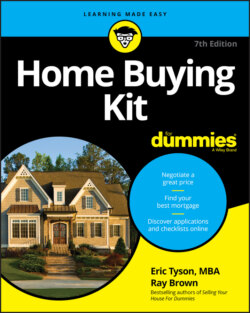Читать книгу Home Buying Kit For Dummies - Eric Tyson - Страница 60
The tax benefits of homeownership
Оглавление One of the benefits of homeownership is that the IRS and most state governments allow you to deduct, within certain limits, mortgage interest and property taxes when you file your annual income tax return. When you file your Federal IRS Form 1040, the mortgage interest and property taxes on your home are itemized deductions on Schedule A (see Figure 3-2, which is available online at www.dummies.com/go/homebuyingkit7e).
Up through 2017, mortgage interest and property tax payments for your home were generally tax-deductible on Schedule A of IRS Form 1040 except for the limitation on the mortgage interest deduction being “limited” to $1,000,000 of debt. There was no limit on property tax deductions.
Source: U.S. Internal Revenue Service
FIGURE 3-2: Itemize mortgage interest and property tax deductions on Schedule A of your 1040.
Effective 2018, due to the Tax Cuts and Jobs Act, the tax benefits of home ownership were further limited, especially for those buying more expensive properties subject to higher property tax bills. The biggest change is that property taxes combined with your state income tax are now limited to a $10,000 annual deduction. And, the mortgage interest deduction now may be claimed on up to $750,000 of mortgage debt (or $1,000,000 if indebtedness was incurred prior to December 16, 2017), which obviously doesn’t affect most home buyers.
Just because mortgage interest and property taxes are allowable deductions on your income tax return, don’t think that the government is literally paying for these items for you. Consider that when you earn a dollar of income and must pay income tax on that dollar, you don’t pay the entire dollar back to the government in taxes. Your tax bracket (see Table 3-2) determines the amount of taxes you pay on that dollar.
TABLE 3-2 2020 Federal Income Tax Brackets and Rates
| Federal Tax Rate | For Single Individuals, Taxable Income Over | For Married Individuals Filing Joint Returns, Taxable Income Over | For Heads of Households, Taxable Income Over |
| 10% | $0 | $0 | $0 |
| 12% | $9,875 | $19,750 | $14,100 |
| 22% | $40,125 | $80,250 | $53,700 |
| 24% | $85,525 | $171,050 | $85,500 |
| 32% | $163,300 | $326,600 | $163,300 |
| 35% | $207,350 | $414,700 | $207,350 |
| 37% | $518,400 | $622,050 | $518,400 |
Because of the new tax bill, determining the tax savings you may realize from homeownership has become much more complicated. Here’s a shortcut that works reasonably well in determining your tax savings in homeownership: Multiply your federal-tax rate (which we explain in a moment) by the portion of your property taxes up to $10,000 when combined with your annual state income tax payments, and the portion of your mortgage payment on up to $750,000 of mortgage debt.
Even if you’re under the $750,000 threshold, not all your mortgage payment is tax-deductible — only the portion of the mortgage payment that goes toward interest. Technically, you pay federal and state taxes, so you should consider your state tax savings as well when calculating your homeownership tax savings. However, to keep things simple and still get a reliable estimate, simply multiply your mortgage payment and property taxes by your federal income tax rate. This shortcut works well because the small portion of your mortgage payment that isn’t deductible (because it’s for the loan repayment) approximately offsets the overlooked state tax savings.
If you want to more accurately determine how homeownership may affect your tax situation, get out your tax return and try plugging in some reasonable numbers to estimate how your taxes will change. You can also speak with a tax advisor.
| Item | Estimated Monthly Expense |
| Mortgage payment | $ |
| Property taxes | + $ |
| Insurance | + $ |
| Improvements, maintenance, and other | + $ |
| Homeownership expenses (pretax) | = $ |
| Tax savings | – $ |
| Homeownership expenses (after tax benefits) | = $ |
The deductibility of the mortgage interest on up to $750,000 borrowed covers debt on both your primary residence and a second residence. (Buying and maintaining two homes is an expensive proposition and something few people can afford, so don’t get any silly ideas from our mentioning this tax tidbit!)
Congratulations! You’ve totaled what your dream home should cost you on a monthly basis after factoring in the tax benefits of homeownership. Don’t forget to plug these expected homeownership costs into your current monthly spending plans (see Chapter 2) to make sure you can afford to spend this much on a home and still accomplish your financial goals.
